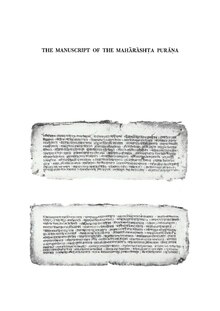Maharashta Purana is a contemporary poetic chronicle of the Maratha invasions of Bengal.
Manuscript
Discovery

Kedarnath Majumdar came across the palm-leaf manuscript — in eleven folios — while collecting biographies of regional poets in Mymensingh c. 1902.[1] It remains the only extant manuscript and is currently conserved at the Manuscript Library of the Bengali Department of the University of Calcutta.[2][3]
Editions
In 1908, Byomakesh Mustafi edited the text for the first time; it was published in Sahitya Parishat Patrika with an introduction and accompanying notes.[4][a] In 1924, Prof. J. N. Samaddar of Patna University published an abridged translation in English with a brief introduction and notes.[4] In 1930, T. C. Dasgupta re-translated the chronicle to English, for a journal published by the University of Calcutta.[5][b] An improved English translation—alongside a critical transliteration and commentary—was published by Edward C. Dimock and Pratul Chandra Gupta in 1965 from the University of Hawaiʻi Press.[6]
Dating
A date in the Bengali calendar—Sanibar, 14th of Pous, saka 1672, sala 1158 (29 December 1751)—is mentioned in the colophon; it might have been the date of completion of composition by the author or the completion of copying by the scribe but provides the terminus ante quem.[3] From the text's conclusion with the death of Bhaskar Ram Kolhatkar (d. March 1744), a terminus post quem of c. 1745 can be imposed.[7]
Author
The Purana was written by Gangaram Dev Chowdhury, a Hindu Kayastha from Dharishwar village who served as a scribe for the local Muslim Zamindari; among his other works were Shuk Sambad and Labkush Charitra.[8]
Genre
A long narrative poem of 716 lines, the meters vary in accordance with the context;[6] despite the name, there is no significant resemblance to the eponymous epical genre.[5] Kumkum Chatterjee locates the text as part of the Mangal-Kāvya corpus; however, Dimock and Gupta held it as a "text of pure secular history."[7]
Content
The raids are covered from their start till the assassination of Bhaskara Pandit.[3] That the last line of the manuscript reads "Thus ends the first part of Maharashtra Puran [...], called Bhaskara-Parahaba", it has been suggested that Gangaram might have had drafted successor volumes.[3]
Legacy
The text remains among the only few works of contemporary vernacular literature to describe the Maratha raids;[9][c] as such, it has been used by historians like Jadunath Sarkar and others to document the history of Marathas and Bengal.[5] Tapan Raychaudhuri uses its example to argue that the premodern literary culture in Bengal did not register any memory of the Islamic Rule in Bengal as uniquely oppressive or tyrannical — such emotional affects would be only produced during the Indian independence movement in service of constructing an imagined national identity around Hinduism.[10]
Notes
References
- ^ Gangaram 1965, p. ix.
- ^ Anandabajar Patrika 2019.
- ^ a b c d Gangaram 1965, p. xi.
- ^ a b Gangaram 1965, p. xix.
- ^ a b c Gangaram 1965, p. xx.
- ^ a b H. 1968.
- ^ a b Chatterjee 2009, p. 103.
- ^ Chatterjee 2009, p. 101.
- ^ a b Gangaram 1965, p. xiii.
- ^ Raychaudhuri 2000, p. 326.
Bibliography
- Gangaram (1965). The Mahārāshṭa Purāṇa: An Eighteenth-Century Bengali Historical Text. Translated by Dimock, Edward C.; Gupta, Pratul Chandra. University of Hawaii Press. doi:10.1515/9780824885892. ISBN 9780824885892.
- H., S. N. (April–June 1968). "Review of The Mahārāshtra Purāṇa, An Eighteenth-Century Bengali Historical Text, by Edward C. Dimock, and Pratul Chandra Gupta". Journal of the American Oriental Society. 88 (2): 384. doi:10.2307/597345. ISSN 0003-0279. JSTOR 597345.
- Raychaudhuri, Tapan (2000). "The Mughal Empire in the Bengali Literary Tradition". Journal of Islamic Studies. 11 (3): 320–334. doi:10.1093/jis/11.3.320. ISSN 0955-2340. JSTOR 26198198.
- গঙ্গারাম বিরচিত মহারাষ্টাপুরাণ. Anandabajar Patrika (in Bengali). 21 July 2019.
- Chatterjee, Kumkum (2009). The Cultures of History in Early Modern India Persianization and Mughal Culture in Bengal. Oxford University Press. doi:10.1093/acprof:oso/9780195698800.001.0001. ISBN 9780195698800.
